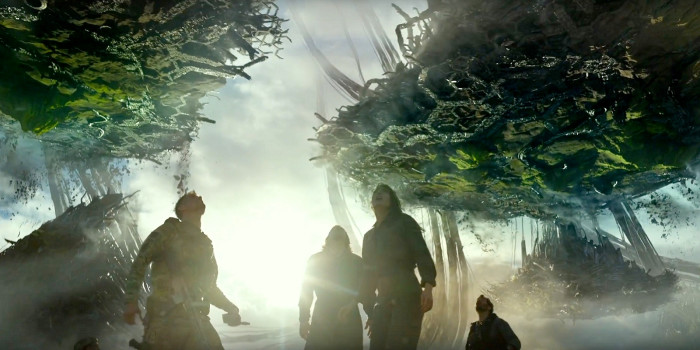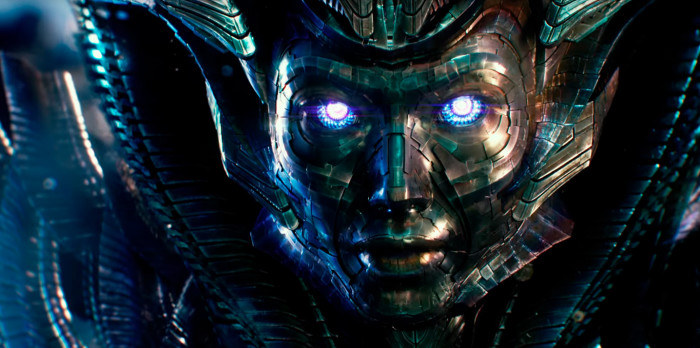'Transformers: The Last Knight' Credits Scene Explained
Transformers: The Last Knight is in theaters now and pretty much everyone agrees that it's quite an insane sequel. It's packed full of so many characters, exposition, and craziness that you kind of need to see it for yourself. Only adding to that insanity is a mid-credits that that sets up sequels, though much like the movie, it doesn't make much sense.
Let's talk about the Transformers The Last Knight credits scene and what it means for the future of the franchise, but beware of spoilers for the sequel if you haven't seen it yet.
Setting the Stage
Before we get to the credits scene, we have to talk about what happened in the movie. The plot of The Last Knight concerns a talisman that came from the Transformers, an energy staff that was handed down to Merlin and a bunch of other craziness. This is all in service of stopping the overarching threat to humanity, which has come from millions of miles away.
At the end of Age of Exctinction, Optimus Prime blasted off from Earth in search of his creators in order to find out why they wanted to have him killed. In The Last Knight, when Prime returns to Cybertron, he meets his creator Quintessa, a metallic goddess who created the Transformers. After explaining to Optimus what happened to his homeworld, she offers him a chance at restoring Cybertron, but how?
Well, we learn that Earth is actually none other than Unicron, a planet-sized Transformer. The horns of Unicron suddenly surface on Earth, which seem to act as beacons that pull Cybertron toward it, but it's not entirely clear what their purpose is. Quintessa explains Unocron can be taken over by the remaining pieces of Cybertron by using Merlin's staff to energize the planet to merge the two worlds into one, which would mean the destruction of Earth as we know it and the death of humanity. Quintessa turns Optimus Prime into Nemesis Prime with a trance and tasks him with getting his hands on the staff so that Cybertron can be returned to its former glory.
To make a long story short, the climactic battle sees Quintessa's plan fail as Optimus Prime is broken from his trance and destroys Quintessa. Earth is saved, although millions are dead (as dictated in the movie), and there are still giant pieces of Cybertron floating around. But Earth may not be as safe as it seems.
Transformers: The Last Knight Credits Scene
After some closing credits, we're thrown into a scene in the desert where one of Unicron's horns is being examined by scientists. Suddenly, a cloaked woman comes into frame, wearing a blue/purple veil. She turns to one of the scientists to say that "he" doesn't like to be touched, but she knows how they can get rid of the horns on the planet.
The woman turns back towards the camera to reveal her face. It's Gemma Chan, who just so happens to be the actress who played Quintessa. Her face is human, but suddenly shimmers with a glimpse of Quintessa's metallic face, indicating that the villain is not dead, and may have some sinister plans for the future.
So what does this all mean? Well, ComicBook.com caught up with producer Lorenzo diBonaventura and asked if Quintessa was some kind of Transformers/human hybrid and just what that scene means. The producer played coy at first and then showed his hand a bit:
"You never know, that's part of what the discovery is gonna be. But actually, if you look at the mythology, the mythology of The Quintessa is that she very well and was probably human. So when you go back in time and go through that 6 billion years of mythology, there's certainly a current of thought within it that says she was a human character and perhaps was actually the first one who built the Transformers. So ironically, if that's accurate, then humans built Transformers."
Of course, if humans are responsible for creating Transformers, all that does is make their history even more complicated than The Last Knight already does. After all, we learned that Transformers came to Earth during the time of the dinosaurs, before there were even humans on the planet. So if Quintessa is really human, then where did she come from? And what does she plan on doing with Unicron?
It's hard to tell how significant this will really be since it seems like each Transformers movie mostly stands on its own with little to no regard for the events of the previous movies. But now that we'll see the mythology of the Transformers movies expand with more sequels and spin-offs based around this secret history brought up in The Last Knight, it's likely not going to mean much in the grand scheme of things.


